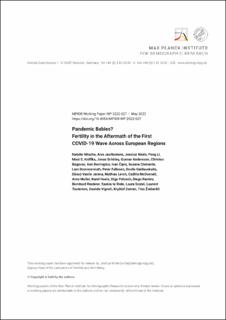| dc.contributor.author | Nitsche, Natalie | |
| dc.contributor.author | Jasilioniene, Aiva | |
| dc.contributor.author | Nisén, Jessica | |
| dc.contributor.author | Li, Peng | |
| dc.contributor.author | Kniffka, Maxi S. | |
| dc.contributor.author | Schöley, Jonas | |
| dc.contributor.author | Andersson, Gunnar | |
| dc.contributor.author | Bagavos, Christos | |
| dc.contributor.author | Berrington, Ann | |
| dc.contributor.author | Čipin, Ivan | |
| dc.contributor.author | Clemente, Susana | |
| dc.contributor.author | Dommermuth, Lars | |
| dc.contributor.author | Fallesen, Peter | |
| dc.contributor.author | Galdauskaite, Dovile | |
| dc.contributor.author | Jemna, Dănuţ-Vasile | |
| dc.contributor.author | Lerch, Mathias | |
| dc.contributor.author | McDonnell, Cadhla | |
| dc.contributor.author | Muller, Arno | |
| dc.contributor.author | Neels, Karel | |
| dc.contributor.author | Pötzsch, Olga | |
| dc.contributor.author | Ramiro, Diego | |
| dc.contributor.author | Riederer, Bernhard | |
| dc.contributor.author | te Riele, Saskia | |
| dc.contributor.author | Szabó, Laura | |
| dc.contributor.author | Toulemon, Laurten | |
| dc.contributor.author | Vignoli, Daniele | |
| dc.contributor.author | Zeman, Kryštof | |
| dc.contributor.author | Žnidaršič, Tina | |
| dc.date.accessioned | 2023-03-01T18:14:28Z | |
| dc.date.available | 2023-03-01T18:14:28Z | |
| dc.date.created | 2022-11-15T16:17:05Z | |
| dc.date.issued | 2022 | |
| dc.identifier.uri | https://hdl.handle.net/11250/3055139 | |
| dc.description.abstract | Early evidence demonstrates that the fertility response to the COVID-19 pandemic has
varied across European countries. Yet, prior research indicates that fertility responses to
disasters are often localized sub-nationally. Moreover, SARS-CoV-2 incidence, economic
pandemic impacts, and the affectedness by virus containment measures varied subnationally across Europe during the first year of the COVID-19 pandemic. Sub-national
variation in the fertility response seems therefore possible. We conducted a rigorous data
collection effort in 28 European countries (equaling 241 European sub-national regions) and
used cutting-edge forecasting methods to assess sub-national variation in the fertility
response to the first six months of the COVID-19 pandemic. While we find sub-national
variation, our results reveal that the fertility response to the pandemic was dominated by
the country level, with Southern European countries witnessing more negative fertility
response to the early pandemic than Northern Europe. Variance decomposition even
indicates a ‘nationalization’ of birth rates during the winter months of 2020, as the withincountry variance in fertility declined and between-country variance increased. Nonetheless,
highly urbanized areas in Europe experienced significantly steeper fertility declines as a
response to the beginning of the pandemic, which is partly explained by their higher SARSCoV-2 incidence rates. SARS-CoV-2 incidence rates emerged as another important predictor
of the fertility response more broadly. Higher incidences were associated with steeper
fertility declines across the regions. Overall, country-level estimates represent fertility
responses to the COVID-19 pandemic generally well, but the regional dimension provides
additional important insight into how the COVID-19 pandemic has impacted fertility. | en_US |
| dc.language.iso | eng | en_US |
| dc.publisher | Max Planck Institute for Demographic Research | en_US |
| dc.rights | Navngivelse-Ikkekommersiell 4.0 Internasjonal | * |
| dc.rights.uri | http://creativecommons.org/licenses/by-nc/4.0/deed.no | * |
| dc.title | Pandemic babies? Fertility in the aftermath of the first COVID-19 wave across European regions | en_US |
| dc.title.alternative | Pandemic babies? Fertility in the aftermath of the first COVID-19 wave across European regions | en_US |
| dc.type | Working paper | en_US |
| dc.description.version | publishedVersion | en_US |
| dc.source.pagenumber | 58 s. | en_US |
| dc.source.journal | MPIDR Working Paper | en_US |
| dc.source.issue | WP 2022-027 | en_US |
| dc.identifier.doi | 10.4054/MPIDR-WP-2022-027 | |
| dc.identifier.cristin | 2074485 | |
| cristin.ispublished | true | |
| cristin.fulltext | original | |

